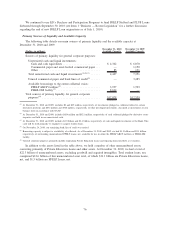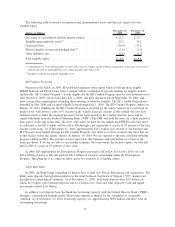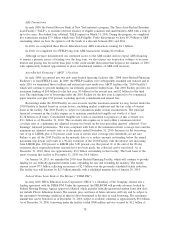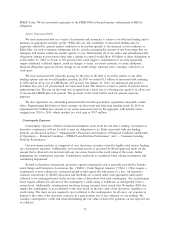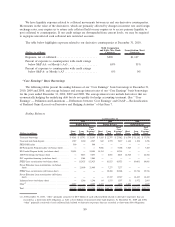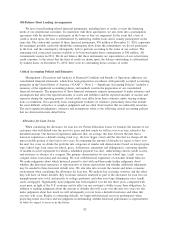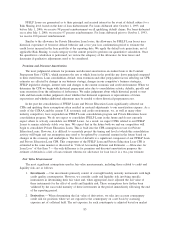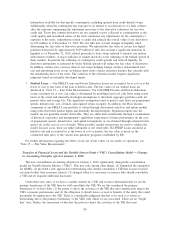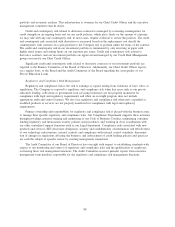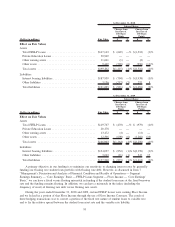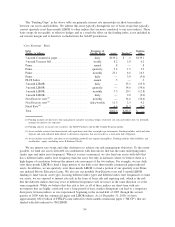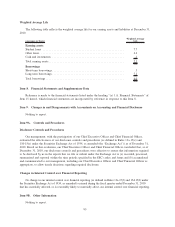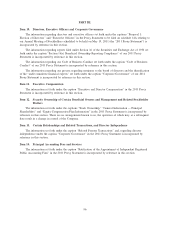Sallie Mae 2010 Annual Report Download - page 87
Download and view the complete annual report
Please find page 87 of the 2010 Sallie Mae annual report below. You can navigate through the pages in the report by either clicking on the pages listed below, or by using the keyword search tool below to find specific information within the annual report.linkage between the management performance process and individual compensation to encourage employees
to work toward corporate-wide compliance goals.
Our Risk Assessment Department monitors our various risk management and compliance efforts, identifies
areas that require increased focus and resources, and reports significant control issues to executive management and
the Audit Committee of our Board of Directors. At least annually, the Risk Assessment Department performs a risk
assessment to identify our top risks, to develop the internal audit plan. Risks are ratedonsignificanceand
likelihood of occurrence and communicated to our management team members who allocate appropriate attention
and resources. Results of the assessment, including survey results, identified risks and recommendations, are
reported to the Audit Committee of our Board of Directors.
Our Board of Directors and its various committees oversee our overall strategic direction and provide
direction to management as to its tolerance levels of various significant risks. Through its committees, our
Board of Directors regularly reviews our risk management practices.
Our Significant Risks
Significant risks may be grouped into the following categories: (1) funding and liquidity; (2) operations;
(3) political/reputation; (4) competition; (5) credit; and (6) regulatory and compliance. More specific
descriptions of the particular risks of each type we currently face are discussed in Item 1A “Risk Factors”.
Funding and Liquidity Risk Management
Funding and liquidity risk is the potential inability to fund liability maturities and deposit withdrawals,
fund asset growth and business operations, and meet contractual obligations at reasonable market rates. Our
primary liquidity objective is to ensure our ongoing ability to meet our funding needs for our businesses
throughout market cycles, including during periods of financial stress. Our two primary liquidity needs are
originating Private Education Loans and retiring secured and unsecured debt when it matures.
We define excess liquidity as readily available assets, limited to cash and high-quality liquid unencum-
bered securities, that we can use to meet our funding requirements as those obligations arise. Our primary
liquidity risk relates to our ability to raise replacement funding and raise that funding at a reasonable cost as
our secured and unsecured debt matures. In addition, we must continue to obtain funding at reasonable rates to
meet our other business obligations and to continue to grow our business. Key risks associated with our
liquidity relates to our ability to access the capital markets and access them at reasonable rates. This ability is
directly affected by our credit ratings. In addition, credit ratings may be important to customers or
counterparties when we compete in certain markets and when we seek to engage in certain transactions,
including over-the-counter derivatives. A negative change in our credit rating would have a negative effect on
our liquidity because it would raise the cost, diminish the availability of funding and potentially require
additional cash collateral or restrict cash currently held as collateral on existing borrowings or derivative
collateral arrangements.
Our funding and liquidity risk management activities are centralized within our Corporate Finance
Department, which is responsible for planning and executing our funding activities and strategies. We analyze
and monitor our liquidity risk, maintain excess liquidity and access diverse funding. Funding and liquidity risk
are overseen and recommendations approved via one or more management committees that manage market,
interest rate and balance sheet risk.
The Finance Committee of the Board of Directors is responsible for approving our Asset and Liability
Management Policy. The Finance Committee of the Board, and in some cases the full Board, monitor our
liquidity on an ongoing basis. Our liquidity risk management activities are centralized within the Corporate
Finance Department, which is responsible for planning and executing our funding activities and strategies.
Operations Risk Management
Operations risk arises from problems with service or product delivery or from nonconformance with
internal policies and procedures. The Company is exposed to transaction risk when products, services or
86


